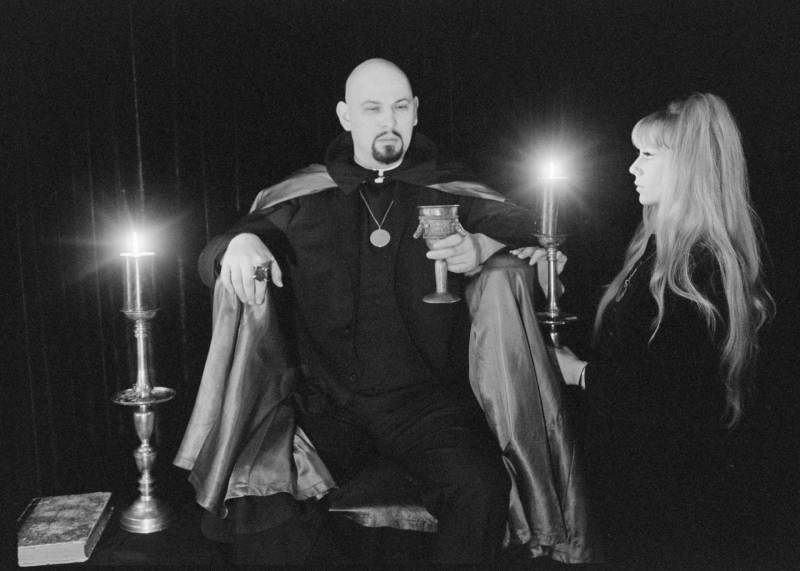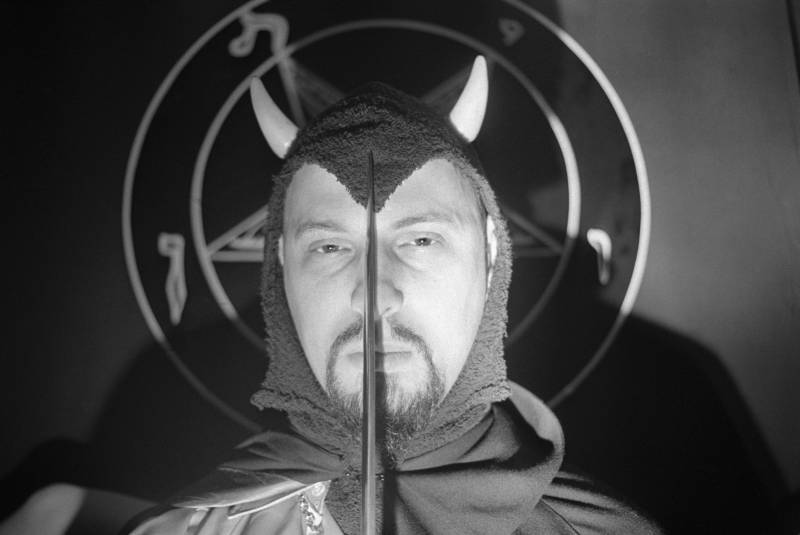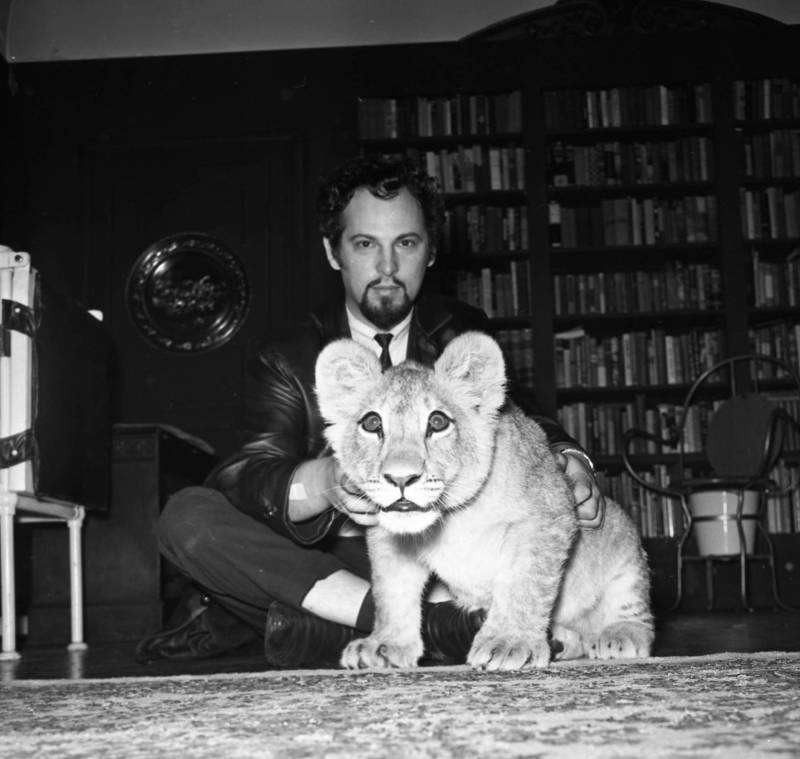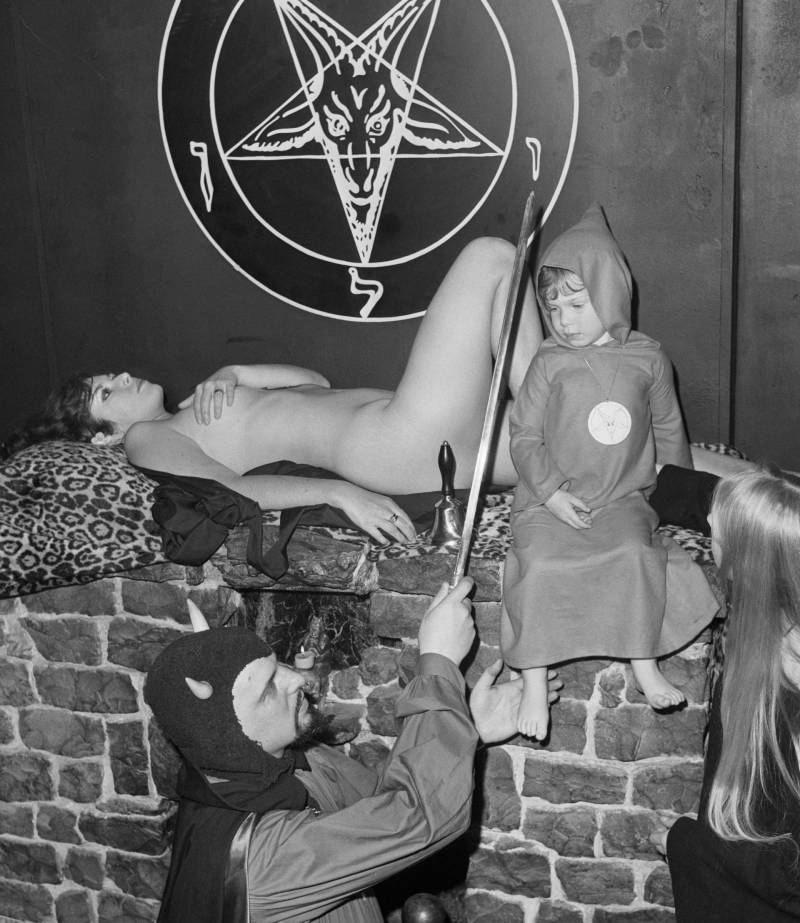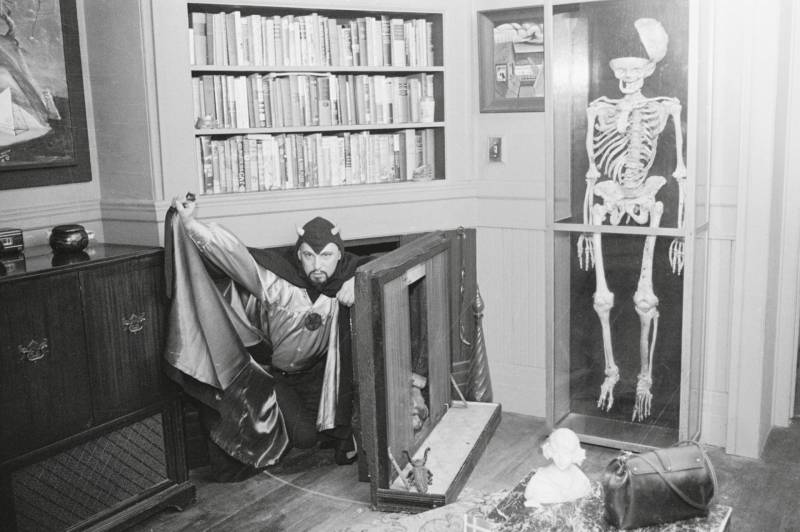Episode Transcript
This is a computer-generated transcript. While our team has reviewed it, there may be errors.
Olivia Allen-Price: If you visited San Francisco’s Richmond District before 2001, and made your way to 6114 California Street, you would have found yourself facing a tall Victorian house that was entirely black.
An attention grabbing paint scheme for sure. But it’s what happened inside The Black House that truly intrigued curious San Francsicans.
It was the first headquarters of the Church of Satan … and the personal home of its founder Anton LaVey. His theatrical nature, and controversial beliefs, turned him into a kind of celebrity… here he is in an interview in 1970…
Joe Pyne: Who ordained you a atanic priest?
Anton LaVey: I would say, probably, I received the call. Just as any fundamentalist—
Pyne: Well most of us do, but we fight it.
LaVey: Why fight it? This is, of course, the whole principle of my religion. All—
Pyne: What do you mean you received the call? You mean one day the devil said “Go out, Anton Szandor LaVey, and give people hell!” [audience laughs]
LaVey: That’s about it. That’s about it. Because people like to have a hell of a time, don’t they?
[Spooky music]
Olivia Allen-Price: How did the Church of Satan get its start in San Francisco? And what was it like to live in the Black House with the so-called “Black Pope” himself?
Welcome to the third installment of Boo Curious! This October we’re bringing you stories about the creepy, the eerie, the misunderstood places around the Bay Area. Today, we explore what was going on inside that Black House. And who, really, was Anton LaVey?
Pyne: Well listen, I’d tell you where to go, but you’d enjoy it… [audience laughs] We’ll be back with another guest…(fade under)
Olivia Allen-Price: I’m Olivia Allen-Price. Now stay close, you don’t want to get lost.
[spooky laugh]
Olivia Allen-Price: We sent producer Amanda Font to make a deal with the devil, and learn more about The Black House, and the Church of Satan’s larger-than-life founder…
Amanda Font: The Bay Area is often associated with countercultural movements. You had the beat poets of the 1950s getting arrested for protesting censorship, the free-loving hippies of the 1960s dropping acid in the park, and the Black Panthers in the 1970s fighting back against institutional racism. What you don’t often hear about alongside those other cultural phenomena is that the late 1960s in San Francisco also gave rise to the notorious, indulgent, and wickedly provocative Church of Satan. [demonic vocal effect on “Church of Satan”]
Amanda Font: In this case, when we use the word “church,” it might not be exactly what you’re picturing. They do describe themselves as a religious organization, but there aren’t a lot of physical church buildings associated with Satanism. It’s more like an organization of like-minded people.
For decades, the black heart of the church, and perhaps still the most recognizable Satanist, was its founder Anton Szandor LaVey. He was born Howard Stanton Levey in Chicago in 1930, and later his family moved to the Bay Area. From a young age, he had a fascination with the supernatural, magic and the idea of trickery.
Anton LaVey [archival]: When I was about 5 years old, I had a friend that had a catalog from the Johnson and Smith company, filled with all of these jokes, tricks, and books on forbidden subjects.
Amanda Font: This is a clip of LaVey from a 1993 documentary about him called “Speak of the Devil.”
Anton LaVey [archival]: It had all the most horrid examples of man’s inhumanity to man, all of course presented in the form of good fun and entertainment.
Amanda Font: Like a toy “recorder box,” that, when you pushed a button, would stab a sharp needle into the finger of an unsuspecting victim. LaVey recalls he didn’t want to play such a mean trick on his friends… but he didn’t mind if it was a kid who was a bully. A similar thought came into play later, when he developed his satanic philosophy. It’s big on the idea of being kind to those who deserve it, but seeking revenge on those who wrong you.
As he got older, LaVey’s curious nature led him to pursue somewhat unusual jobs. In his early life, he claimed to have worked in a circus with big cats, as a psychic investigator, an organist, a hypnotist, and to have been a police photographer for the SFPD (although there are no official records to back that last one.)
In 1956, a decade before he officially created the Church of Satan, he was already cultivating the kind of dark aesthetic that people would come to know him for. LaVey bought the Victorian house at 6114 California Street and painted it black.
Blanche Barton: And as he said, the roots went all The way to hell.
Amanda Font: This is Blanche Barton…
Blanche Barton: I am the current Magistra Templi Rex of the Church of Satan. I’ve been a member of the organization. Wow, almost 50 years now. And I was a high priestess for a time.
Amanda Font: She also was Anton LaVey’s romantic partner for 13 years, and they had a child together. Blanche, or Magistra Barton has written two books about the Church of Satan, including a biography of Anton LaVey called “The Secret Life of a Satanist,” and “The Church of Satan: A History of the World’s Most Notorious Religion.” Blanche says even before the house became a satanic sanctuary, like so many old San Francisco Victorians, the house itself had an interesting history.
Blanche Barton: It was Built in 1887, as far as the stories go, by a Scottish sea captain. And there were timbers in the lower levels that had come to San Francisco During the gold rush, and it had trapdoors and it had been used as a whorehouse and a speakeasy. It had a bar downstairs. It had secret passageways.
Amanda Font: When he purchased the house in ‘56, LaVey lived there with his first wife and their young daughter, Karla. And as his interests in the supernatural deepened, he surrounded himself with a group of friends who were curious about the same things.
Blanche Barton: The Church of Satan, sort of grew out of what he called the Magic Circle. They were all intrigued by the weird and the unexplained. They started sort of having soirees and that sort of led into ritualizing, to see, practically, what happens or if anything happens. He started presenting seminars on the various topics that he was interested in from, vampires to cannibalism. Everything weird and wonderful.
[spooky music]
Amanda Font: And in 1966, the people in that magic circle became the first members of the Church of Satan… picture it… a dark night, April 30th, Walpurgisnacht — a German holiday with Pagan origins, sometimes called “The night of the witches.” On that night Anton LaVey ritualistically shaved his head in the tradition of medieval executioners and dark magicians, adopting the look he’d have for the rest of his life, and declared 1966 to be the first year of the reign of Satan, thus founding America’s first official Satanic church.
And from there, it became a kind of hit…
[swinging music]
LaVey claimed that the church had hundreds of members in San Francisco and thousands throughout the world. He was a natural showman, with his shiny polished bald head, black goatee, and intense eyes. He wore all black, a long cloak, large rings, a pentagram medallion, and would make appearances wearing a hooded devil costume with little horns.
He had a 500-pound pet lion named Togare who he’d raised from a cub, that slept in his bedroom at night. He invited reporters and the public inside the Black House to attend Satanic Mass…
[Archival recording of Satanic Mass]
…Where he’d invoke the devil while wielding a large sword or sometimes a boa constrictor while a nude woman was draped across the altar in the ritual chamber. He even married people.
News clip of LaVey marrying couple: “Former New York socialite Judith Chase and John Raymond were joined in unholy wedlock before a live altar, a nude redhead. Self-ordained sorcerer/minister Anton Levey presided at the San Francisco ceremony.”
Amanda Font: The media absolutely ate it up. They started calling him the Black Pope.
News clip of LaVey marrying couple: “As the worst man looks on, the blessings of Lucifer and Beelzebub are invoked. The elaborate rite smacked of publicity, because next day the bride and groom secured a conventional wedding license”
Amanda Font: LaVey was charismatic and people seemed to gravitate to him. He became a kind of overnight celebrity. He was interviewed on national television, in magazines, people across the country were seeing his face. Even people who seemed to hate him wanted to interview him… Like talk show host Joe Pyne…
Pyne: Are you married?
LaVey: Oh yes
Pyne: You have any little devils?
LaVey: Oh yes. I have two.
Pyne: Are you gonna raise them as satanic kids?
LaVey: Certainly, but not to go around chopping people up as sacrificing human beings just to—
Pyne: That would be the greatest reward of all. If your kids some night would creep in and set fire to you and your lion, then dance around with pitchforks saying “Hey look at daddy, look at daddy!” (audience laughs)
Amanda Font: But it seemed like all kinds of people were at least curious about the church. At one time, Sammy Davis Jr. and Liberace were linked to the Church of Satan. In 1966 the actress Jayne Mansfield met LaVey at a film festival in San Francisco and they began an unlikely friendship. There are numerous photos of them together, even performing a ritual at Mansfield’s home, though Mansfield said she was a Catholic and simply found LaVey intriguing. Some people blame her untimely death in a car crash a year later on an alleged curse LaVey put on the driver of the car… but who’s to say?
Controversies made the news. Famously, in 1967 he baptized his then 3-year-old daughter Zeena into the church, dedicating her to Satan while her mother, LaVey’s 2nd partner Diane Hegarty, looked on.
Archival clip of LaVey baptizing Zeena: In the name of our great god, Satan Lucifer, I command thee to come forth an bestow these blessings upon us…(fades down and LaVey continues)
Amanda Font: So how much of LaVey’s highly theatrical image was serious? Well, while much of the ritualizing was akin to performance art, he was sincere in his philosophy. LaVey published “The Satanic Bible,” which by now has sold over a million copies, outlining his beliefs. The number one sin in Satanism is stupidity or willful ignorance. Herd conformity is also up there. He founded the Church of Satan as an alternative to what he saw as the repression of many other mainstream religions. Denying human nature, he said, was the real sin. Indulgence is key.
Anton LaVey [archival]: No religion had ever been based on man’s carnal needs or his fleshly pursuits.
Amanda Font: This is a clip of LaVey from a documentary filmed in those first few years of the church called “Satanis: The Devil’s Mass”
Anton LaVey [archival]: All religions are based on abstinence instead of indulgence. All religions therefore have to be based on fear. Well, we don’t feel that fear is necessary to base a religion on.
Amanda Font: Not everyone was a fan, of course. He was telling people to embrace their animal nature… give in to their dark and lustful desires. Christian groups were appalled, obviously, and what about the neighbors? Here’s Blanche Barton again…
Blanche Barton: One of the most amusing parts of the film, almost endearing, is when they go out and talk to the neighbors. And it’s pretty funny. You know, they say that they see the nude people dancing around in the front. And they saw the lion — eating something! Really quite, quite devilish and intriguing. (laughs)
[Clip from ‘Satanis: The Devil’s Mass]
Neighbor 1: He’s been in the neighborhood about 14 years and I always knew him as Tony. Just a nice ordinary — well — a little more dramatic than most men in the neighborhood, perhaps.
Neighbor 2: Actually I don’t know what kind of man he is. As soon as you meet him, you think he’s a very very nice man, you know. I just had a feeling I can trust him.
Neighbor 3: (grumbling) A very undesirable type of a neighbor.
Amanda Font: Neighbors successfully petitioned to have LaVey’s pet lion relocated in the late 60s. He first landed in a zoo, then ended up at a big cat sanctuary in Southern California.
As for the goings on at the church, the nude rituals, wild events, blaspheming…well, freedom of religion! They weren’t doing anything illegal. Still, by the 70s, LaVey had stopped inviting the press in for all the rituals, instead focusing more on cultivating new members. He was living in a world of his own aesthetic making, which is a primary tenet of his satanic philosophy.
Blanche Barton: Anton Levey was first and foremost an artist. He felt that aesthetics, whatever you are most drawn to, is what you should use. If you’re really excited about Frankenstein or if you are very drawn to technology. Because what you do in the ritual chamber is you’re evoking your emotions. Nothing comes from outside. It’s not coming from Satan or demons or anything. But we know the power that Humans have for creating a world and a life for yourself.
Amanda Font: LaVey was making a living through the church, taking speaking engagements and charging initiation fees for new members. He also sometimes worked as an organist at local clubs. He spent more of his time making art, and music, another passion.
Blanche Barton: He got the most joy out of playing. Keyboards because he could control the entire orchestra.
[Clip of Anton LaVey playing keyboards]
Amanda Font: He even pressed a record. Much of it includes recordings of early satanic masses, but also just, you know, some songs…
[Anton LaVey singing a song called ‘Honolulu Baby’]
Blanche Barton: His specific aesthetics were very much in the forties. A lot of the precepts of Satanism that he developed are very much, sort of, grounded in his creative self.
[Anton LaVey singing, music fades out]
Blanche Barton: And then in the Eighties, there was the Satanic Panic going on.
Amanda Font: In the 1980s and through the 90s there was a national wave of fear that “Satanic Cults” were taking over.
Clip from training video: Anton LaVey, perhaps the best-known Satanist in America compiled his years of cult knowledge into two books: the Satanic Bible, and the Satanic Rituals.
Amanda Font: This is from an hourlong police training video from 1993, filmed in San Francisco, that was created to teach law enforcement how to spot satanic symbols and investigate “satanic crimes.”
Clip from training video: Now remember, not all satanic people commit crimes. Some of their activities may be perfectly legal.
Amanda Font: It has all the highly stereotypical suggestions about what kinds of illegal activities Satanists might engage in….
Clip from training video: Murder, which might include human sacrifice, or mass murders or cannibalism…(fade under)
Amanda Font: Some of them, frankly, are pretty macabre.
Clip from training video: Corpse theft, cemetery vandalism, black market sales of bones and skulls, black market baby selling…(fade under)
[Dramatic music]
Amanda Font: To be clear, these things weren’t happening. It’s kind of funny now, especially set to that music, but at that time the fear that these things were actually happening was intense. Through the 80s and 90s upwards of 10-thousand unsubstantiated claims of ritualistic abuse by supposed satanic cults were made, though not directly against the Church of Satan.
This was happening in California, and all over the United States. It was like the witch trials all over again. There were numerous high-profile cases where people were convicted of satanic crimes, only to be exonerated after serving years, sometimes decades, in prison.
Blanche Barton: But at the same time, there was a real excitement. From younger people who were. Sort of discovering Satanism because of the satanic. Panic. You know, people were jumping up and down and. Saying, “Oh, this is so evil, this is so. Bad.” And yet they would. Publish the satanic statements and the young kids would say, Well, that seems pretty sensible. To me.
Amanda Font: Because, here’s the thing a lot of people get wrong about The Church of Satan. Satanists don’t worship the devil. They don’t drink blood, sacrifice babies or animals. They don’t even believe in the literal devil. They’re atheists. Satanism is more of a philosophy.
Blanche Barton: What the Satanic Bible tries to advocate is independent study, not worship. There is no dogma. You know, we honor animals. We honor children. It’s against self-deceit, kindness to those who deserve it rather than love wasted on ingrates. And the last one, of course, people get a chuckle out of because we say, we recognize that Satan is the best friend that the church has ever had…
Anton LaVey [archival]: The devil is the guy that’s kept the church in business for many many years. Without him, and the concept of evil, where would the church be?
Amanda Font: Using a satanic adversary to represent an ideology of personal freedom and indulging without guilt… Blanche says it’s really more of a style choice. That’s what drew her in…She wanted to embrace her dark and sensual side.
Blanche Barton: I was looking for a philosophy that really represented women and a freedom for women and their lust. And their desires and their habits and their beauty and their wisdom. And I felt that most organized religions just did not have a voice for me.
Amanda Font: Blanche had been following the Church of Satan through her teenage years and early 20s in Southern California, even coming to San Francisco to meet Anton LaVey.
Blanche Barton: From our first meeting we felt a draw to each other. And from that time we spent a lot of time on the phone and corresponding back and forth.
Amanda Font: Less than a year later in 1984, just after graduating college, she moves to San Francisco at the age of 22. Shortly thereafter they became romantically involved. Blanche moved into the Black House in 1989.
Blanche Barton: We had a wonderful life together. It had a rhythm. Of course, he was very nocturnal. So a lot of times we would get up at four or five in the evening and meet people. Play music, converse, maybe watch a Movie And then we would go to sleep around dawn.
Amanda Font: Rituals were no longer public, but occasional private events. LaVey wasn’t willing to present the Church of Satan as just a curiosity anymore. In 1993, Blanche gave birth to their son, his third child, Satan Xerxes. At that point, LaVey was 63 years old.
MUSIC
Joe Pyne: So is it necessary to drive a stake through your heart to kill you, or would an ordinary knock on the head do it?
LaVey: I will never die.
Pyne: You won’t?
LaVey: No, of course not. I’ve made arrangements. (audience ooohs)
Amanda Font: Anton LaVey died from heart disease at St. Mary’s in San Francisco on October 29th, 1997. Although his official death certificate lists his expiration date as Halloween.
So what happens when the core of the Church of Satan, the man who was its central flame, gets snuffed out?
Well, Blanche served as high priestess, the top leadership position, for a few years, before stepping down and handing the reins over to longtime member Peter Gilmore, who is still its high priest. The church left San Francisco and now has a new ‘Black House’ in New York state.
LaVey’s oldest daughter, Karla, was also high-priestess for a time but left the Church of Satan to start her own “First Satanic Church” in San Francisco. It’s a lot more exclusive and is known for throwing a great Black X-Mass concert in the city every year for the last couple decades.
Zeena, who was dedicated to Satan as a toddler, left Satanism entirely and became a Tantric Buddhist.
His son, Satan Xerxes, isn’t involved at all and lives a private life.
As for the infamous Black House…
Blanche Barton: It was an amazing house and it should have been preserved. And we did try.
Amanda Font: LaVey had been forced to sell the house to a friend in the early 90s though he was allowed to live there until his death. But the house was in disrepair, and the land was just too valuable. When efforts to find a preservation group willing to take it on failed, the property was sold and torn down in 2001.
What stands there now is a very normal-looking apartment building. No lingering signs that it was once a raucous den of sin.
Olivia Allen-Price: That was Bay Curious producer Amanda Font.
That’s it for today’s installment in our Boo Curious series. If you’ve been digging it, please share with a friend, or leave us a five-star rating or review on Apple Podcasts or wherever you listen.
